ECU Project Management: A Comparison of PMBOK and Agile Methodologies
VerifiedAdded on 2023/06/03
|14
|2660
|325
Report
AI Summary
This report provides a comprehensive comparison of the Project Management Body of Knowledge (PMBOK) and Agile project management methodologies. It begins with an executive summary and introduction, outlining the paper's purpose: to analyze and contrast these two approaches for enhancing project efficiency. The report then delves into detailed descriptions of both PMBOK, including its knowledge areas (integration, scope, time, cost, quality, human resources, communication, risk, procurement, and stakeholder engagement), and Agile project management, including its iterative processes (pre-planning, planning, release planning, iteration planning, managing product structure, increased communication, and continuous reviewing). A comparative analysis highlights the features, practical applications, project processes, knowledge areas, principles, techniques, stakeholder roles, environmental impacts, managerial advantages, and disadvantages of each methodology. The conclusion emphasizes the suitability of PMBOK for larger projects and Agile for smaller projects with dynamic customer requirements. The report concludes by highlighting the benefits of each methodology in terms of risk reduction, time management, and cost efficiency. The report includes references to relevant academic literature.
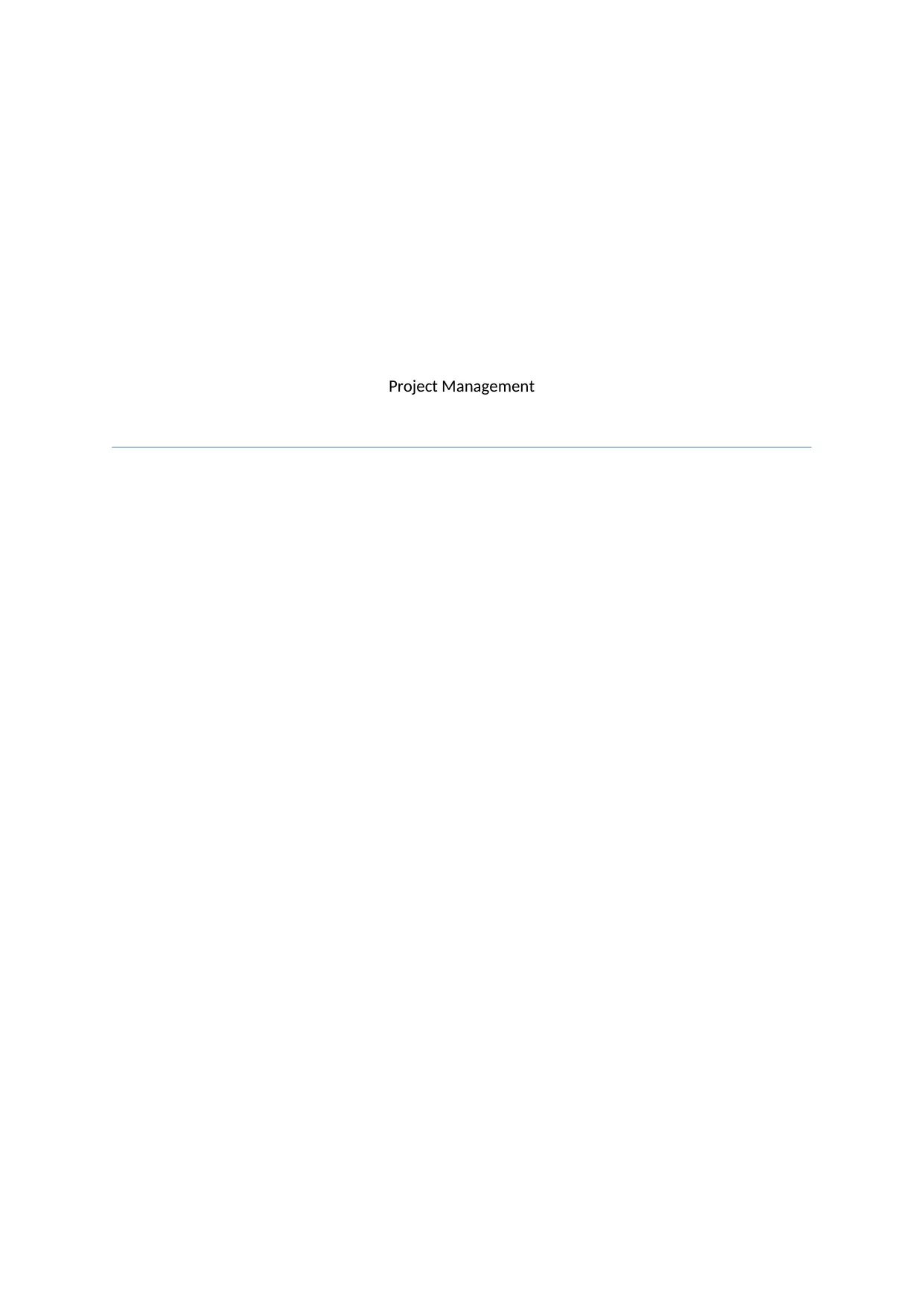
Project Management
Paraphrase This Document
Need a fresh take? Get an instant paraphrase of this document with our AI Paraphraser
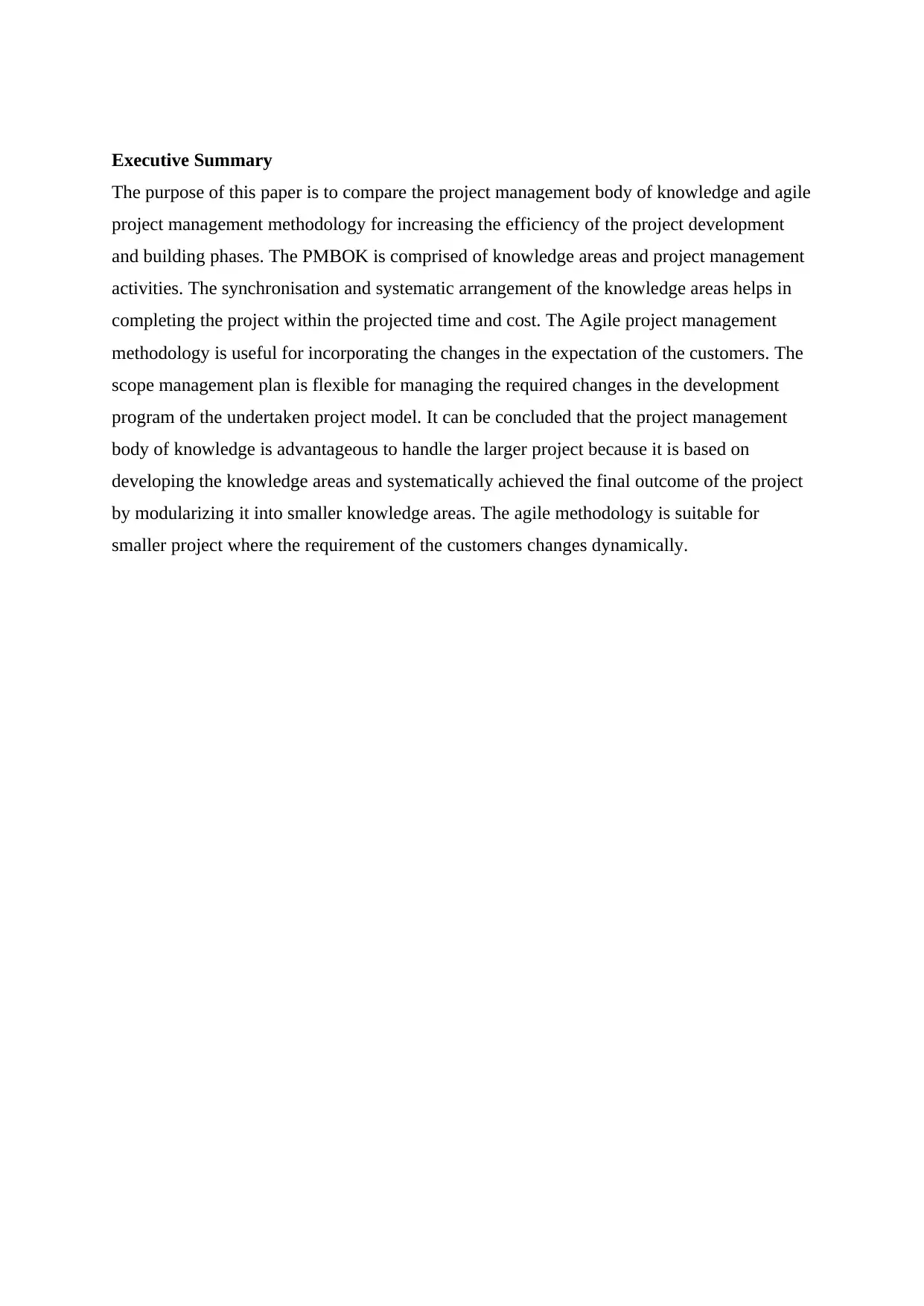
Executive Summary
The purpose of this paper is to compare the project management body of knowledge and agile
project management methodology for increasing the efficiency of the project development
and building phases. The PMBOK is comprised of knowledge areas and project management
activities. The synchronisation and systematic arrangement of the knowledge areas helps in
completing the project within the projected time and cost. The Agile project management
methodology is useful for incorporating the changes in the expectation of the customers. The
scope management plan is flexible for managing the required changes in the development
program of the undertaken project model. It can be concluded that the project management
body of knowledge is advantageous to handle the larger project because it is based on
developing the knowledge areas and systematically achieved the final outcome of the project
by modularizing it into smaller knowledge areas. The agile methodology is suitable for
smaller project where the requirement of the customers changes dynamically.
The purpose of this paper is to compare the project management body of knowledge and agile
project management methodology for increasing the efficiency of the project development
and building phases. The PMBOK is comprised of knowledge areas and project management
activities. The synchronisation and systematic arrangement of the knowledge areas helps in
completing the project within the projected time and cost. The Agile project management
methodology is useful for incorporating the changes in the expectation of the customers. The
scope management plan is flexible for managing the required changes in the development
program of the undertaken project model. It can be concluded that the project management
body of knowledge is advantageous to handle the larger project because it is based on
developing the knowledge areas and systematically achieved the final outcome of the project
by modularizing it into smaller knowledge areas. The agile methodology is suitable for
smaller project where the requirement of the customers changes dynamically.
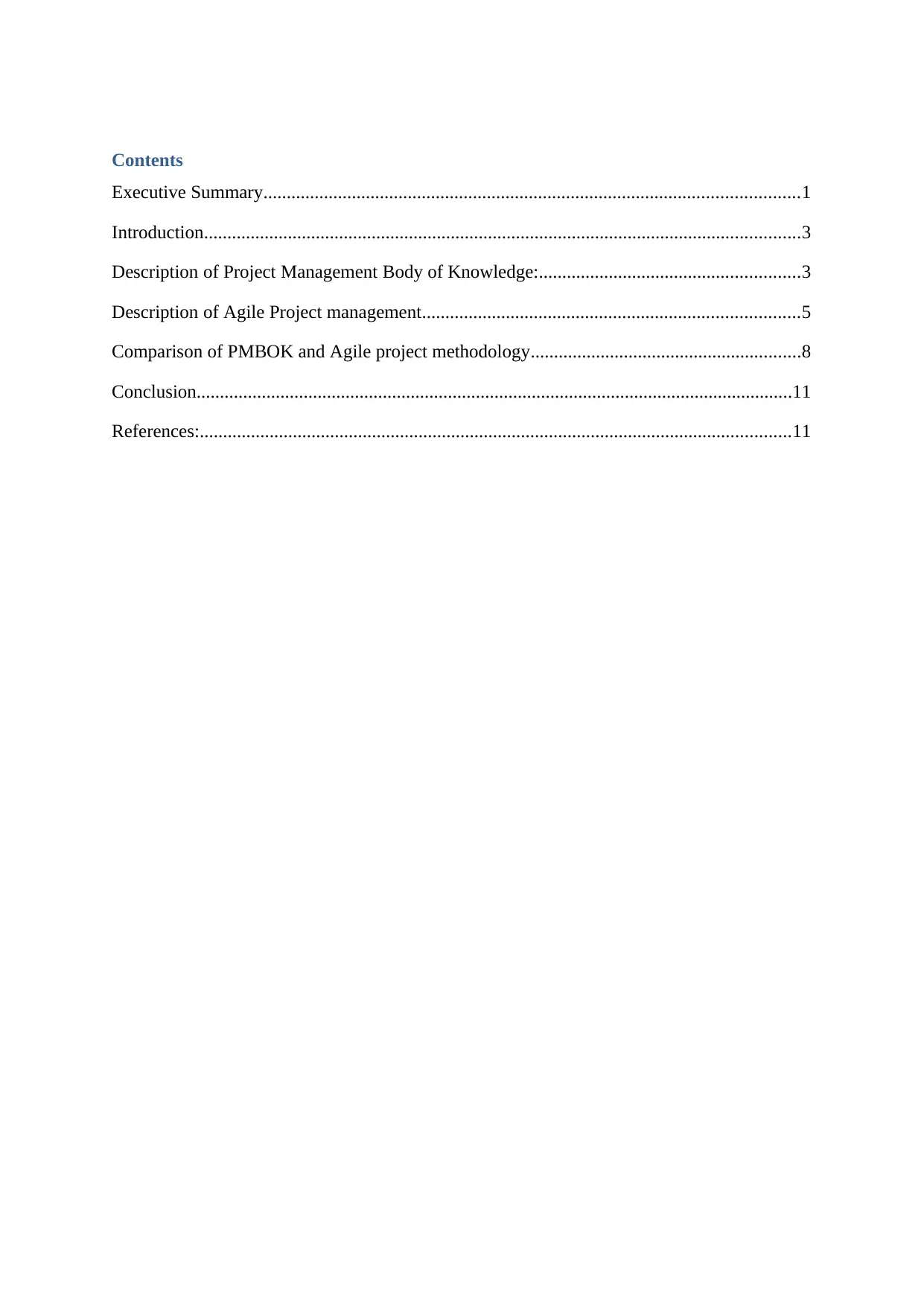
Contents
Executive Summary...................................................................................................................1
Introduction................................................................................................................................3
Description of Project Management Body of Knowledge:........................................................3
Description of Agile Project management.................................................................................5
Comparison of PMBOK and Agile project methodology..........................................................8
Conclusion................................................................................................................................11
References:...............................................................................................................................11
Executive Summary...................................................................................................................1
Introduction................................................................................................................................3
Description of Project Management Body of Knowledge:........................................................3
Description of Agile Project management.................................................................................5
Comparison of PMBOK and Agile project methodology..........................................................8
Conclusion................................................................................................................................11
References:...............................................................................................................................11
⊘ This is a preview!⊘
Do you want full access?
Subscribe today to unlock all pages.

Trusted by 1+ million students worldwide
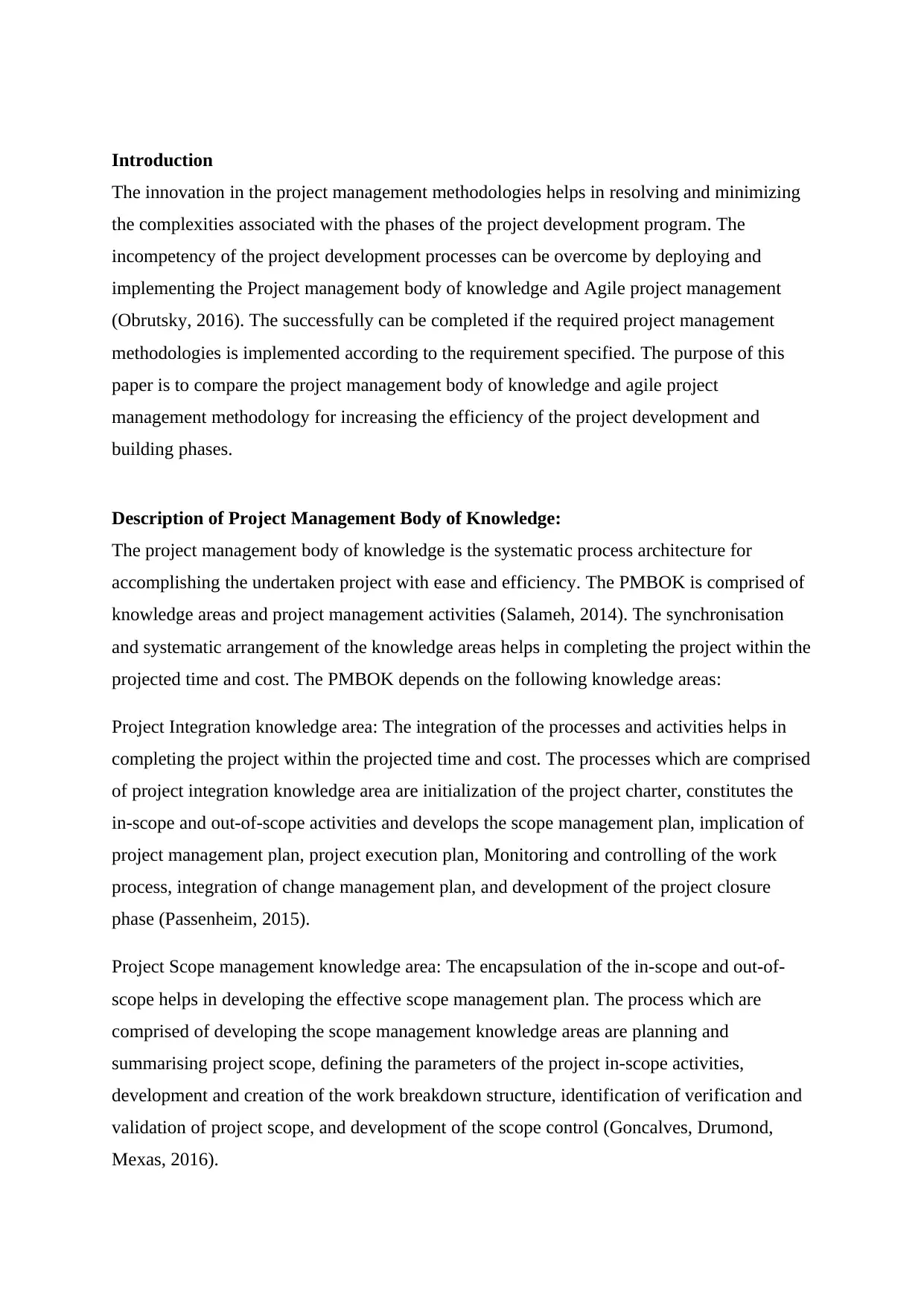
Introduction
The innovation in the project management methodologies helps in resolving and minimizing
the complexities associated with the phases of the project development program. The
incompetency of the project development processes can be overcome by deploying and
implementing the Project management body of knowledge and Agile project management
(Obrutsky, 2016). The successfully can be completed if the required project management
methodologies is implemented according to the requirement specified. The purpose of this
paper is to compare the project management body of knowledge and agile project
management methodology for increasing the efficiency of the project development and
building phases.
Description of Project Management Body of Knowledge:
The project management body of knowledge is the systematic process architecture for
accomplishing the undertaken project with ease and efficiency. The PMBOK is comprised of
knowledge areas and project management activities (Salameh, 2014). The synchronisation
and systematic arrangement of the knowledge areas helps in completing the project within the
projected time and cost. The PMBOK depends on the following knowledge areas:
Project Integration knowledge area: The integration of the processes and activities helps in
completing the project within the projected time and cost. The processes which are comprised
of project integration knowledge area are initialization of the project charter, constitutes the
in-scope and out-of-scope activities and develops the scope management plan, implication of
project management plan, project execution plan, Monitoring and controlling of the work
process, integration of change management plan, and development of the project closure
phase (Passenheim, 2015).
Project Scope management knowledge area: The encapsulation of the in-scope and out-of-
scope helps in developing the effective scope management plan. The process which are
comprised of developing the scope management knowledge areas are planning and
summarising project scope, defining the parameters of the project in-scope activities,
development and creation of the work breakdown structure, identification of verification and
validation of project scope, and development of the scope control (Goncalves, Drumond,
Mexas, 2016).
The innovation in the project management methodologies helps in resolving and minimizing
the complexities associated with the phases of the project development program. The
incompetency of the project development processes can be overcome by deploying and
implementing the Project management body of knowledge and Agile project management
(Obrutsky, 2016). The successfully can be completed if the required project management
methodologies is implemented according to the requirement specified. The purpose of this
paper is to compare the project management body of knowledge and agile project
management methodology for increasing the efficiency of the project development and
building phases.
Description of Project Management Body of Knowledge:
The project management body of knowledge is the systematic process architecture for
accomplishing the undertaken project with ease and efficiency. The PMBOK is comprised of
knowledge areas and project management activities (Salameh, 2014). The synchronisation
and systematic arrangement of the knowledge areas helps in completing the project within the
projected time and cost. The PMBOK depends on the following knowledge areas:
Project Integration knowledge area: The integration of the processes and activities helps in
completing the project within the projected time and cost. The processes which are comprised
of project integration knowledge area are initialization of the project charter, constitutes the
in-scope and out-of-scope activities and develops the scope management plan, implication of
project management plan, project execution plan, Monitoring and controlling of the work
process, integration of change management plan, and development of the project closure
phase (Passenheim, 2015).
Project Scope management knowledge area: The encapsulation of the in-scope and out-of-
scope helps in developing the effective scope management plan. The process which are
comprised of developing the scope management knowledge areas are planning and
summarising project scope, defining the parameters of the project in-scope activities,
development and creation of the work breakdown structure, identification of verification and
validation of project scope, and development of the scope control (Goncalves, Drumond,
Mexas, 2016).
Paraphrase This Document
Need a fresh take? Get an instant paraphrase of this document with our AI Paraphraser
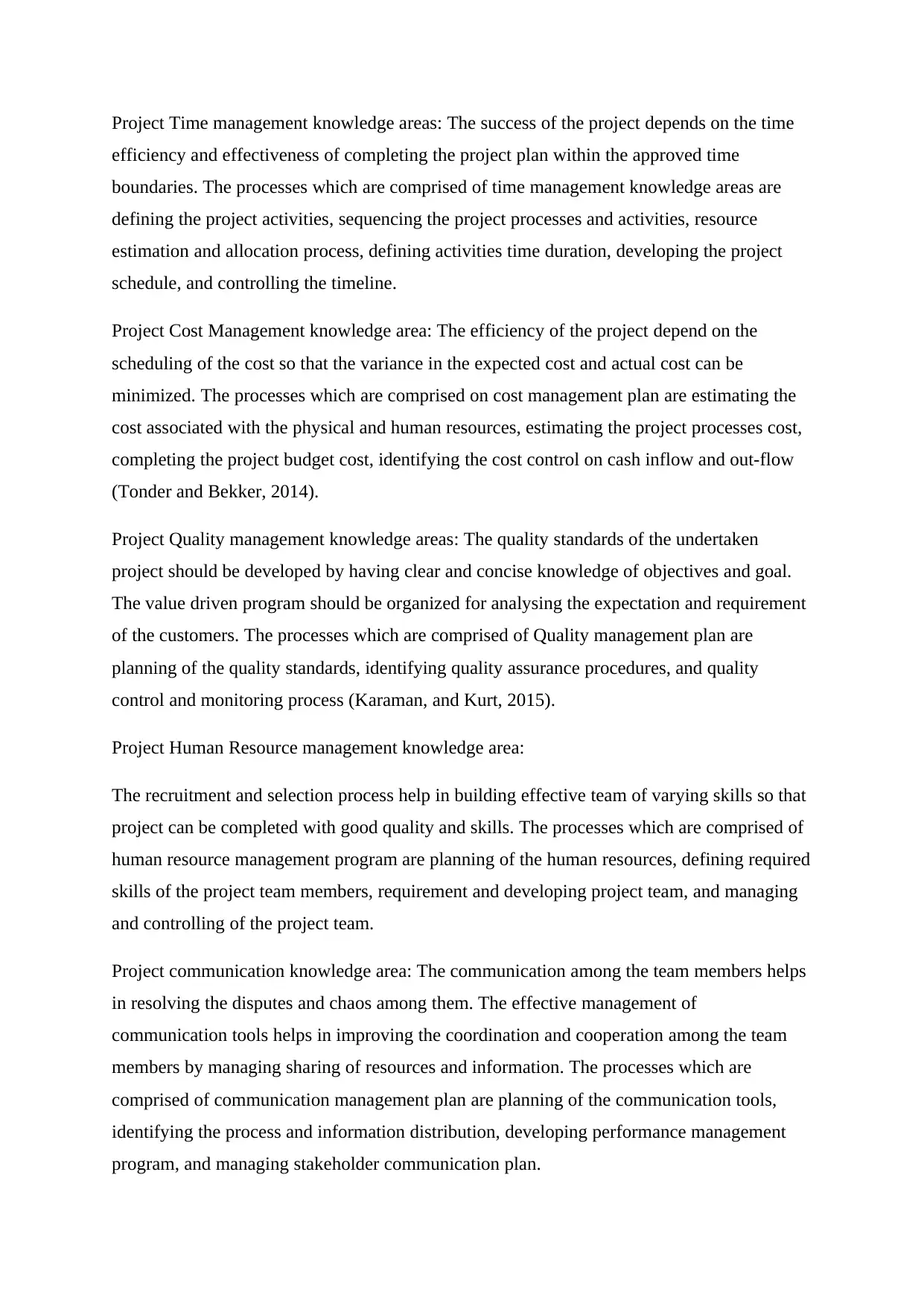
Project Time management knowledge areas: The success of the project depends on the time
efficiency and effectiveness of completing the project plan within the approved time
boundaries. The processes which are comprised of time management knowledge areas are
defining the project activities, sequencing the project processes and activities, resource
estimation and allocation process, defining activities time duration, developing the project
schedule, and controlling the timeline.
Project Cost Management knowledge area: The efficiency of the project depend on the
scheduling of the cost so that the variance in the expected cost and actual cost can be
minimized. The processes which are comprised on cost management plan are estimating the
cost associated with the physical and human resources, estimating the project processes cost,
completing the project budget cost, identifying the cost control on cash inflow and out-flow
(Tonder and Bekker, 2014).
Project Quality management knowledge areas: The quality standards of the undertaken
project should be developed by having clear and concise knowledge of objectives and goal.
The value driven program should be organized for analysing the expectation and requirement
of the customers. The processes which are comprised of Quality management plan are
planning of the quality standards, identifying quality assurance procedures, and quality
control and monitoring process (Karaman, and Kurt, 2015).
Project Human Resource management knowledge area:
The recruitment and selection process help in building effective team of varying skills so that
project can be completed with good quality and skills. The processes which are comprised of
human resource management program are planning of the human resources, defining required
skills of the project team members, requirement and developing project team, and managing
and controlling of the project team.
Project communication knowledge area: The communication among the team members helps
in resolving the disputes and chaos among them. The effective management of
communication tools helps in improving the coordination and cooperation among the team
members by managing sharing of resources and information. The processes which are
comprised of communication management plan are planning of the communication tools,
identifying the process and information distribution, developing performance management
program, and managing stakeholder communication plan.
efficiency and effectiveness of completing the project plan within the approved time
boundaries. The processes which are comprised of time management knowledge areas are
defining the project activities, sequencing the project processes and activities, resource
estimation and allocation process, defining activities time duration, developing the project
schedule, and controlling the timeline.
Project Cost Management knowledge area: The efficiency of the project depend on the
scheduling of the cost so that the variance in the expected cost and actual cost can be
minimized. The processes which are comprised on cost management plan are estimating the
cost associated with the physical and human resources, estimating the project processes cost,
completing the project budget cost, identifying the cost control on cash inflow and out-flow
(Tonder and Bekker, 2014).
Project Quality management knowledge areas: The quality standards of the undertaken
project should be developed by having clear and concise knowledge of objectives and goal.
The value driven program should be organized for analysing the expectation and requirement
of the customers. The processes which are comprised of Quality management plan are
planning of the quality standards, identifying quality assurance procedures, and quality
control and monitoring process (Karaman, and Kurt, 2015).
Project Human Resource management knowledge area:
The recruitment and selection process help in building effective team of varying skills so that
project can be completed with good quality and skills. The processes which are comprised of
human resource management program are planning of the human resources, defining required
skills of the project team members, requirement and developing project team, and managing
and controlling of the project team.
Project communication knowledge area: The communication among the team members helps
in resolving the disputes and chaos among them. The effective management of
communication tools helps in improving the coordination and cooperation among the team
members by managing sharing of resources and information. The processes which are
comprised of communication management plan are planning of the communication tools,
identifying the process and information distribution, developing performance management
program, and managing stakeholder communication plan.
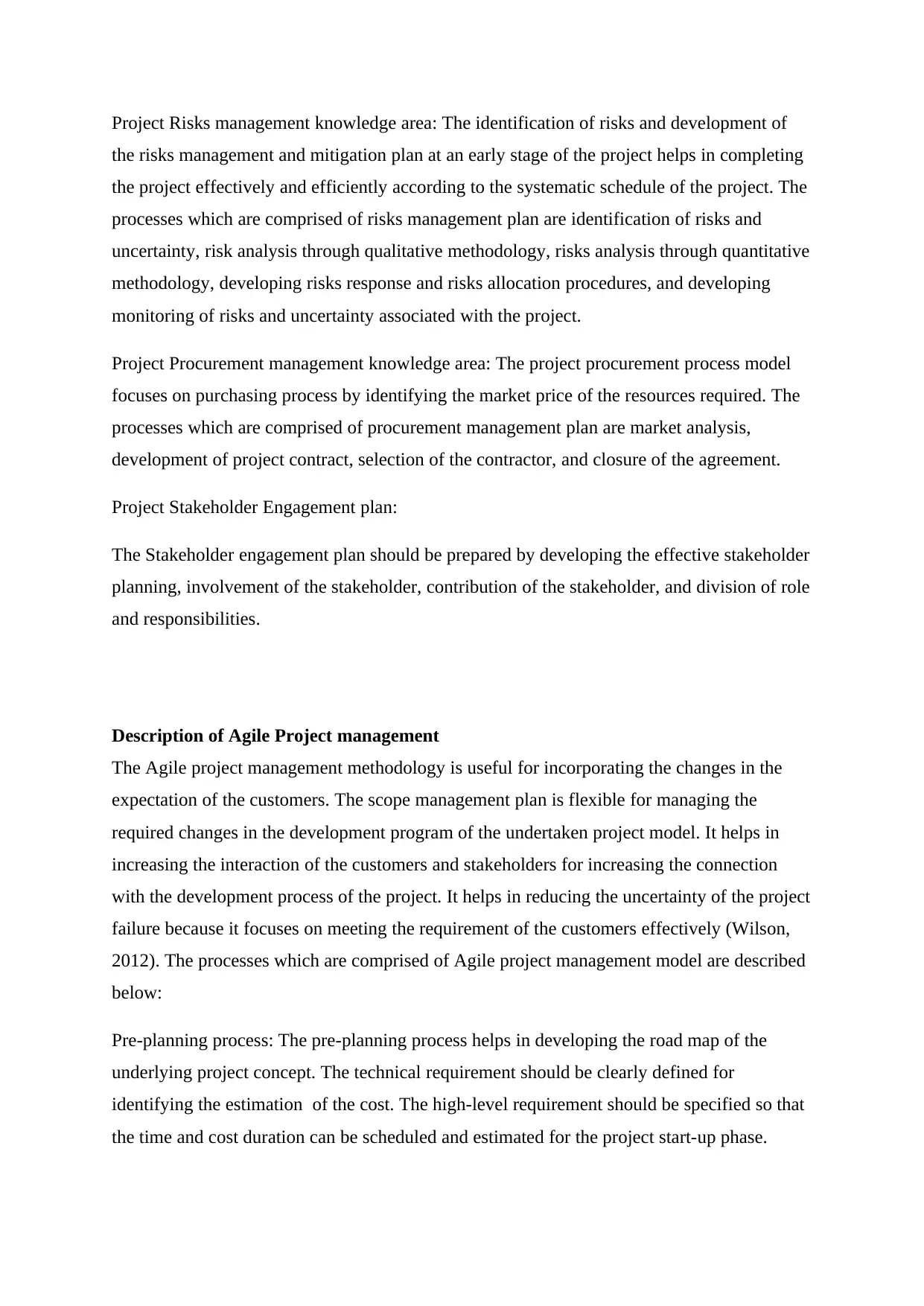
Project Risks management knowledge area: The identification of risks and development of
the risks management and mitigation plan at an early stage of the project helps in completing
the project effectively and efficiently according to the systematic schedule of the project. The
processes which are comprised of risks management plan are identification of risks and
uncertainty, risk analysis through qualitative methodology, risks analysis through quantitative
methodology, developing risks response and risks allocation procedures, and developing
monitoring of risks and uncertainty associated with the project.
Project Procurement management knowledge area: The project procurement process model
focuses on purchasing process by identifying the market price of the resources required. The
processes which are comprised of procurement management plan are market analysis,
development of project contract, selection of the contractor, and closure of the agreement.
Project Stakeholder Engagement plan:
The Stakeholder engagement plan should be prepared by developing the effective stakeholder
planning, involvement of the stakeholder, contribution of the stakeholder, and division of role
and responsibilities.
Description of Agile Project management
The Agile project management methodology is useful for incorporating the changes in the
expectation of the customers. The scope management plan is flexible for managing the
required changes in the development program of the undertaken project model. It helps in
increasing the interaction of the customers and stakeholders for increasing the connection
with the development process of the project. It helps in reducing the uncertainty of the project
failure because it focuses on meeting the requirement of the customers effectively (Wilson,
2012). The processes which are comprised of Agile project management model are described
below:
Pre-planning process: The pre-planning process helps in developing the road map of the
underlying project concept. The technical requirement should be clearly defined for
identifying the estimation of the cost. The high-level requirement should be specified so that
the time and cost duration can be scheduled and estimated for the project start-up phase.
the risks management and mitigation plan at an early stage of the project helps in completing
the project effectively and efficiently according to the systematic schedule of the project. The
processes which are comprised of risks management plan are identification of risks and
uncertainty, risk analysis through qualitative methodology, risks analysis through quantitative
methodology, developing risks response and risks allocation procedures, and developing
monitoring of risks and uncertainty associated with the project.
Project Procurement management knowledge area: The project procurement process model
focuses on purchasing process by identifying the market price of the resources required. The
processes which are comprised of procurement management plan are market analysis,
development of project contract, selection of the contractor, and closure of the agreement.
Project Stakeholder Engagement plan:
The Stakeholder engagement plan should be prepared by developing the effective stakeholder
planning, involvement of the stakeholder, contribution of the stakeholder, and division of role
and responsibilities.
Description of Agile Project management
The Agile project management methodology is useful for incorporating the changes in the
expectation of the customers. The scope management plan is flexible for managing the
required changes in the development program of the undertaken project model. It helps in
increasing the interaction of the customers and stakeholders for increasing the connection
with the development process of the project. It helps in reducing the uncertainty of the project
failure because it focuses on meeting the requirement of the customers effectively (Wilson,
2012). The processes which are comprised of Agile project management model are described
below:
Pre-planning process: The pre-planning process helps in developing the road map of the
underlying project concept. The technical requirement should be clearly defined for
identifying the estimation of the cost. The high-level requirement should be specified so that
the time and cost duration can be scheduled and estimated for the project start-up phase.
⊘ This is a preview!⊘
Do you want full access?
Subscribe today to unlock all pages.

Trusted by 1+ million students worldwide
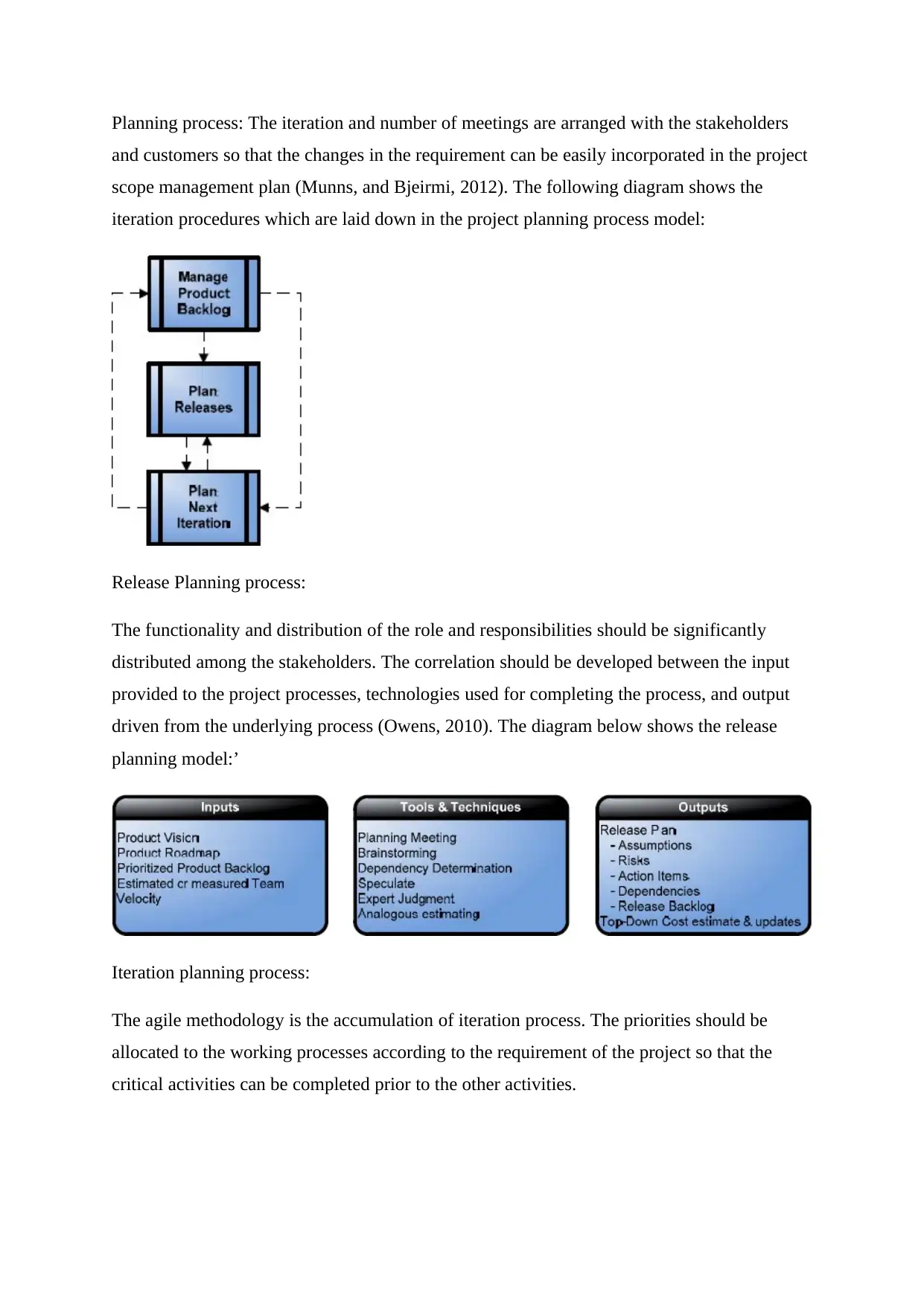
Planning process: The iteration and number of meetings are arranged with the stakeholders
and customers so that the changes in the requirement can be easily incorporated in the project
scope management plan (Munns, and Bjeirmi, 2012). The following diagram shows the
iteration procedures which are laid down in the project planning process model:
Release Planning process:
The functionality and distribution of the role and responsibilities should be significantly
distributed among the stakeholders. The correlation should be developed between the input
provided to the project processes, technologies used for completing the process, and output
driven from the underlying process (Owens, 2010). The diagram below shows the release
planning model:’
Iteration planning process:
The agile methodology is the accumulation of iteration process. The priorities should be
allocated to the working processes according to the requirement of the project so that the
critical activities can be completed prior to the other activities.
and customers so that the changes in the requirement can be easily incorporated in the project
scope management plan (Munns, and Bjeirmi, 2012). The following diagram shows the
iteration procedures which are laid down in the project planning process model:
Release Planning process:
The functionality and distribution of the role and responsibilities should be significantly
distributed among the stakeholders. The correlation should be developed between the input
provided to the project processes, technologies used for completing the process, and output
driven from the underlying process (Owens, 2010). The diagram below shows the release
planning model:’
Iteration planning process:
The agile methodology is the accumulation of iteration process. The priorities should be
allocated to the working processes according to the requirement of the project so that the
critical activities can be completed prior to the other activities.
Paraphrase This Document
Need a fresh take? Get an instant paraphrase of this document with our AI Paraphraser
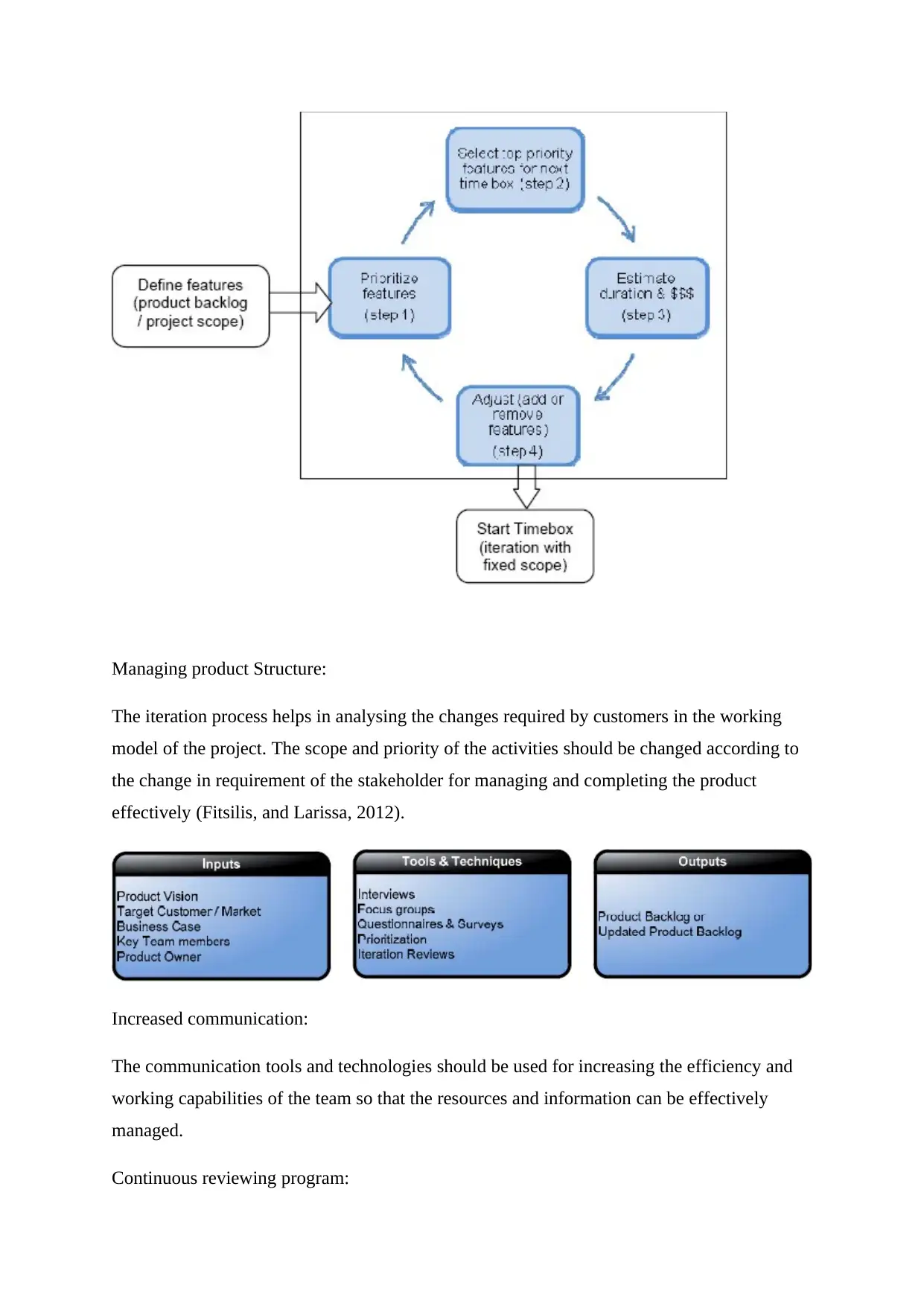
Managing product Structure:
The iteration process helps in analysing the changes required by customers in the working
model of the project. The scope and priority of the activities should be changed according to
the change in requirement of the stakeholder for managing and completing the product
effectively (Fitsilis, and Larissa, 2012).
Increased communication:
The communication tools and technologies should be used for increasing the efficiency and
working capabilities of the team so that the resources and information can be effectively
managed.
Continuous reviewing program:
The iteration process helps in analysing the changes required by customers in the working
model of the project. The scope and priority of the activities should be changed according to
the change in requirement of the stakeholder for managing and completing the product
effectively (Fitsilis, and Larissa, 2012).
Increased communication:
The communication tools and technologies should be used for increasing the efficiency and
working capabilities of the team so that the resources and information can be effectively
managed.
Continuous reviewing program:
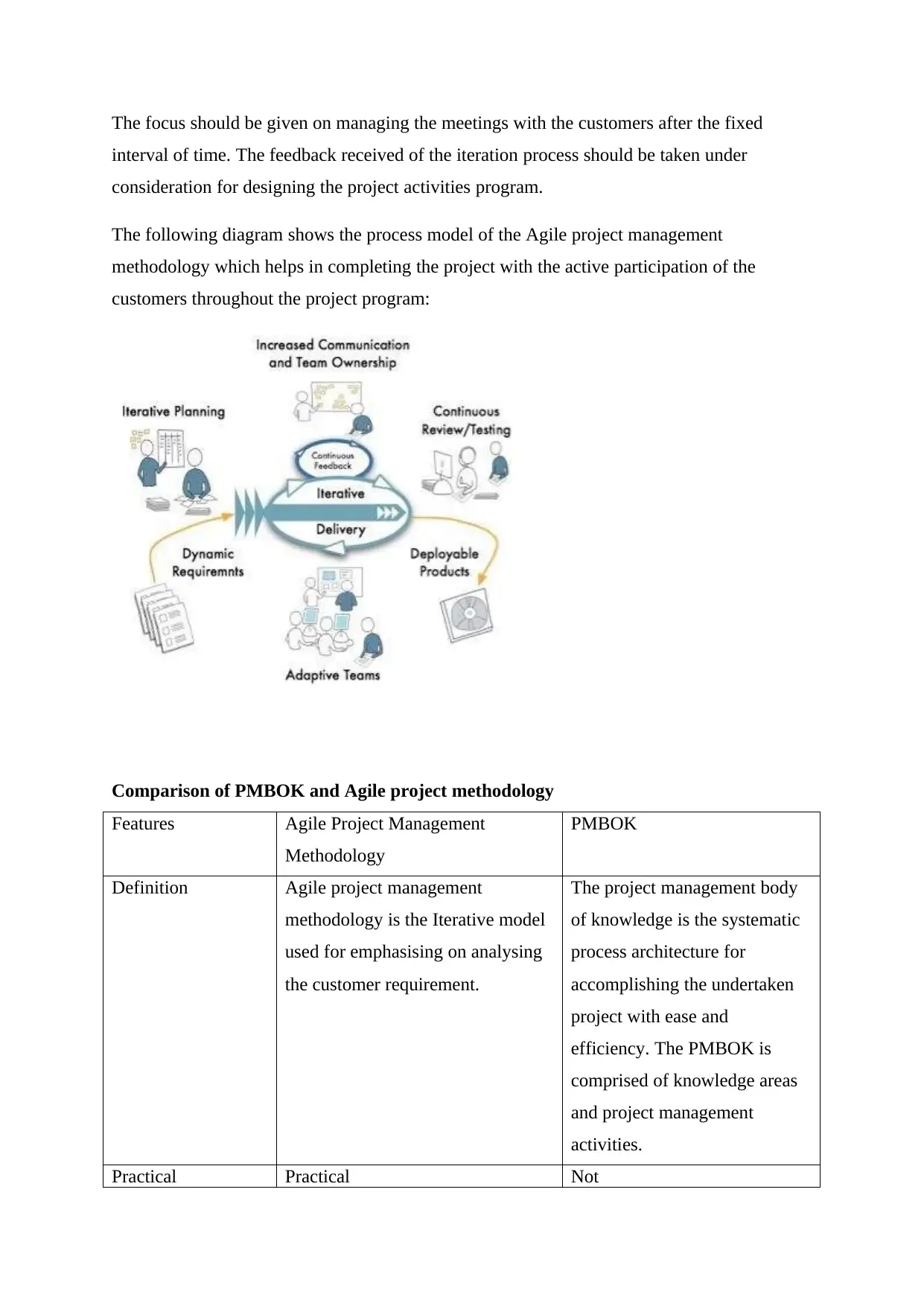
The focus should be given on managing the meetings with the customers after the fixed
interval of time. The feedback received of the iteration process should be taken under
consideration for designing the project activities program.
The following diagram shows the process model of the Agile project management
methodology which helps in completing the project with the active participation of the
customers throughout the project program:
Comparison of PMBOK and Agile project methodology
Features Agile Project Management
Methodology
PMBOK
Definition Agile project management
methodology is the Iterative model
used for emphasising on analysing
the customer requirement.
The project management body
of knowledge is the systematic
process architecture for
accomplishing the undertaken
project with ease and
efficiency. The PMBOK is
comprised of knowledge areas
and project management
activities.
Practical Practical Not
interval of time. The feedback received of the iteration process should be taken under
consideration for designing the project activities program.
The following diagram shows the process model of the Agile project management
methodology which helps in completing the project with the active participation of the
customers throughout the project program:
Comparison of PMBOK and Agile project methodology
Features Agile Project Management
Methodology
PMBOK
Definition Agile project management
methodology is the Iterative model
used for emphasising on analysing
the customer requirement.
The project management body
of knowledge is the systematic
process architecture for
accomplishing the undertaken
project with ease and
efficiency. The PMBOK is
comprised of knowledge areas
and project management
activities.
Practical Practical Not
⊘ This is a preview!⊘
Do you want full access?
Subscribe today to unlock all pages.

Trusted by 1+ million students worldwide
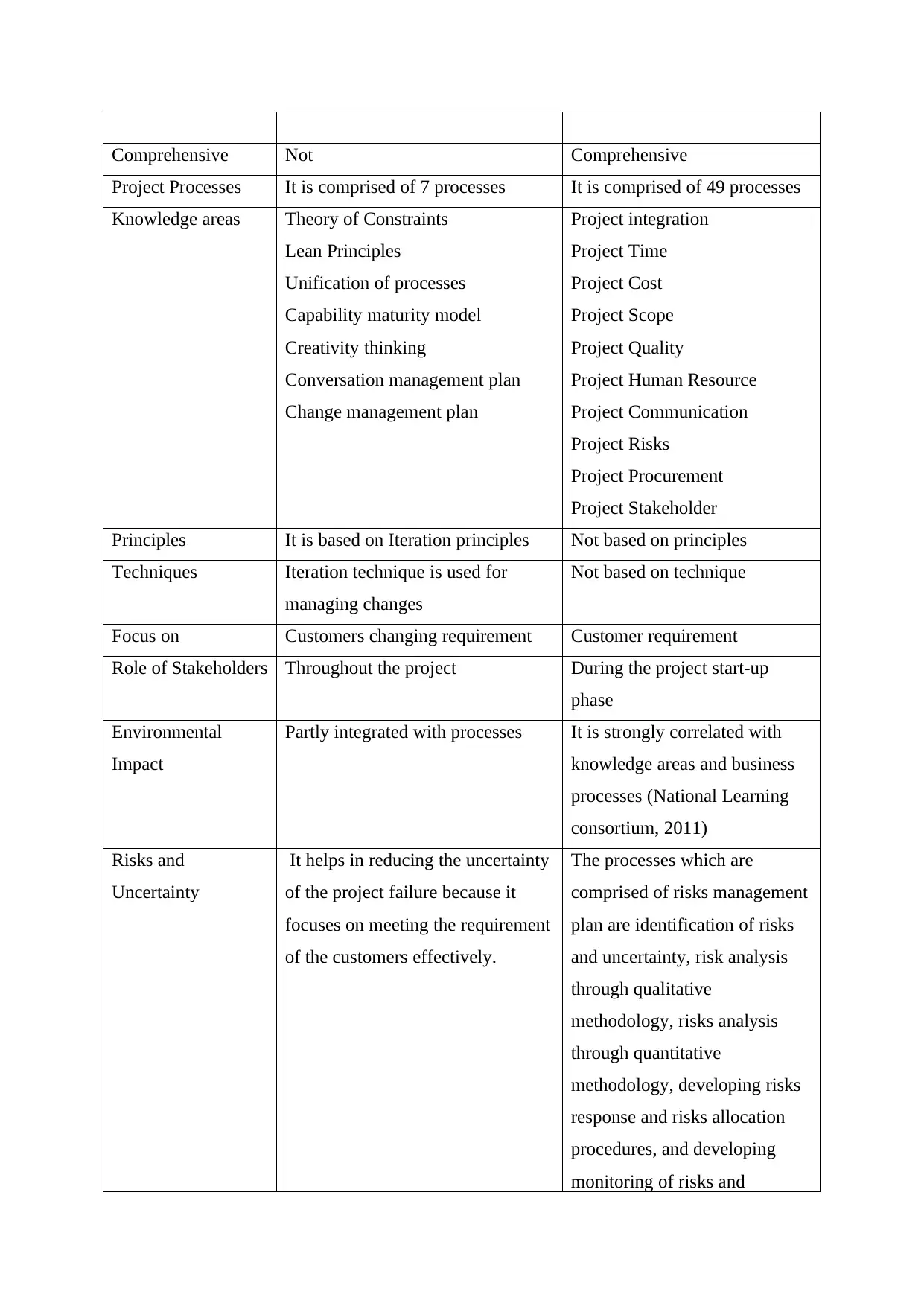
Comprehensive Not Comprehensive
Project Processes It is comprised of 7 processes It is comprised of 49 processes
Knowledge areas Theory of Constraints
Lean Principles
Unification of processes
Capability maturity model
Creativity thinking
Conversation management plan
Change management plan
Project integration
Project Time
Project Cost
Project Scope
Project Quality
Project Human Resource
Project Communication
Project Risks
Project Procurement
Project Stakeholder
Principles It is based on Iteration principles Not based on principles
Techniques Iteration technique is used for
managing changes
Not based on technique
Focus on Customers changing requirement Customer requirement
Role of Stakeholders Throughout the project During the project start-up
phase
Environmental
Impact
Partly integrated with processes It is strongly correlated with
knowledge areas and business
processes (National Learning
consortium, 2011)
Risks and
Uncertainty
It helps in reducing the uncertainty
of the project failure because it
focuses on meeting the requirement
of the customers effectively.
The processes which are
comprised of risks management
plan are identification of risks
and uncertainty, risk analysis
through qualitative
methodology, risks analysis
through quantitative
methodology, developing risks
response and risks allocation
procedures, and developing
monitoring of risks and
Project Processes It is comprised of 7 processes It is comprised of 49 processes
Knowledge areas Theory of Constraints
Lean Principles
Unification of processes
Capability maturity model
Creativity thinking
Conversation management plan
Change management plan
Project integration
Project Time
Project Cost
Project Scope
Project Quality
Project Human Resource
Project Communication
Project Risks
Project Procurement
Project Stakeholder
Principles It is based on Iteration principles Not based on principles
Techniques Iteration technique is used for
managing changes
Not based on technique
Focus on Customers changing requirement Customer requirement
Role of Stakeholders Throughout the project During the project start-up
phase
Environmental
Impact
Partly integrated with processes It is strongly correlated with
knowledge areas and business
processes (National Learning
consortium, 2011)
Risks and
Uncertainty
It helps in reducing the uncertainty
of the project failure because it
focuses on meeting the requirement
of the customers effectively.
The processes which are
comprised of risks management
plan are identification of risks
and uncertainty, risk analysis
through qualitative
methodology, risks analysis
through quantitative
methodology, developing risks
response and risks allocation
procedures, and developing
monitoring of risks and
Paraphrase This Document
Need a fresh take? Get an instant paraphrase of this document with our AI Paraphraser
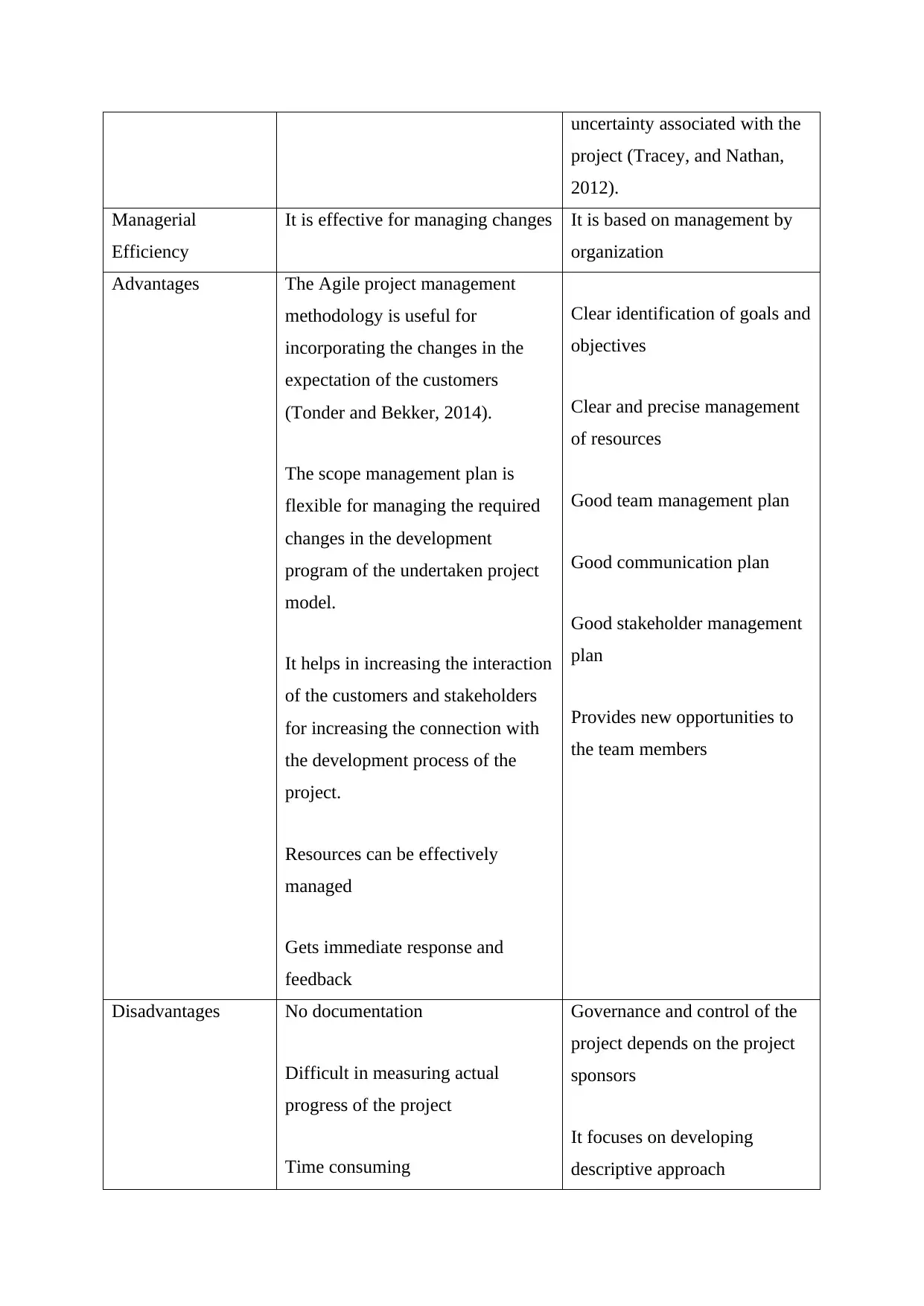
uncertainty associated with the
project (Tracey, and Nathan,
2012).
Managerial
Efficiency
It is effective for managing changes It is based on management by
organization
Advantages The Agile project management
methodology is useful for
incorporating the changes in the
expectation of the customers
(Tonder and Bekker, 2014).
The scope management plan is
flexible for managing the required
changes in the development
program of the undertaken project
model.
It helps in increasing the interaction
of the customers and stakeholders
for increasing the connection with
the development process of the
project.
Resources can be effectively
managed
Gets immediate response and
feedback
Clear identification of goals and
objectives
Clear and precise management
of resources
Good team management plan
Good communication plan
Good stakeholder management
plan
Provides new opportunities to
the team members
Disadvantages No documentation
Difficult in measuring actual
progress of the project
Time consuming
Governance and control of the
project depends on the project
sponsors
It focuses on developing
descriptive approach
project (Tracey, and Nathan,
2012).
Managerial
Efficiency
It is effective for managing changes It is based on management by
organization
Advantages The Agile project management
methodology is useful for
incorporating the changes in the
expectation of the customers
(Tonder and Bekker, 2014).
The scope management plan is
flexible for managing the required
changes in the development
program of the undertaken project
model.
It helps in increasing the interaction
of the customers and stakeholders
for increasing the connection with
the development process of the
project.
Resources can be effectively
managed
Gets immediate response and
feedback
Clear identification of goals and
objectives
Clear and precise management
of resources
Good team management plan
Good communication plan
Good stakeholder management
plan
Provides new opportunities to
the team members
Disadvantages No documentation
Difficult in measuring actual
progress of the project
Time consuming
Governance and control of the
project depends on the project
sponsors
It focuses on developing
descriptive approach
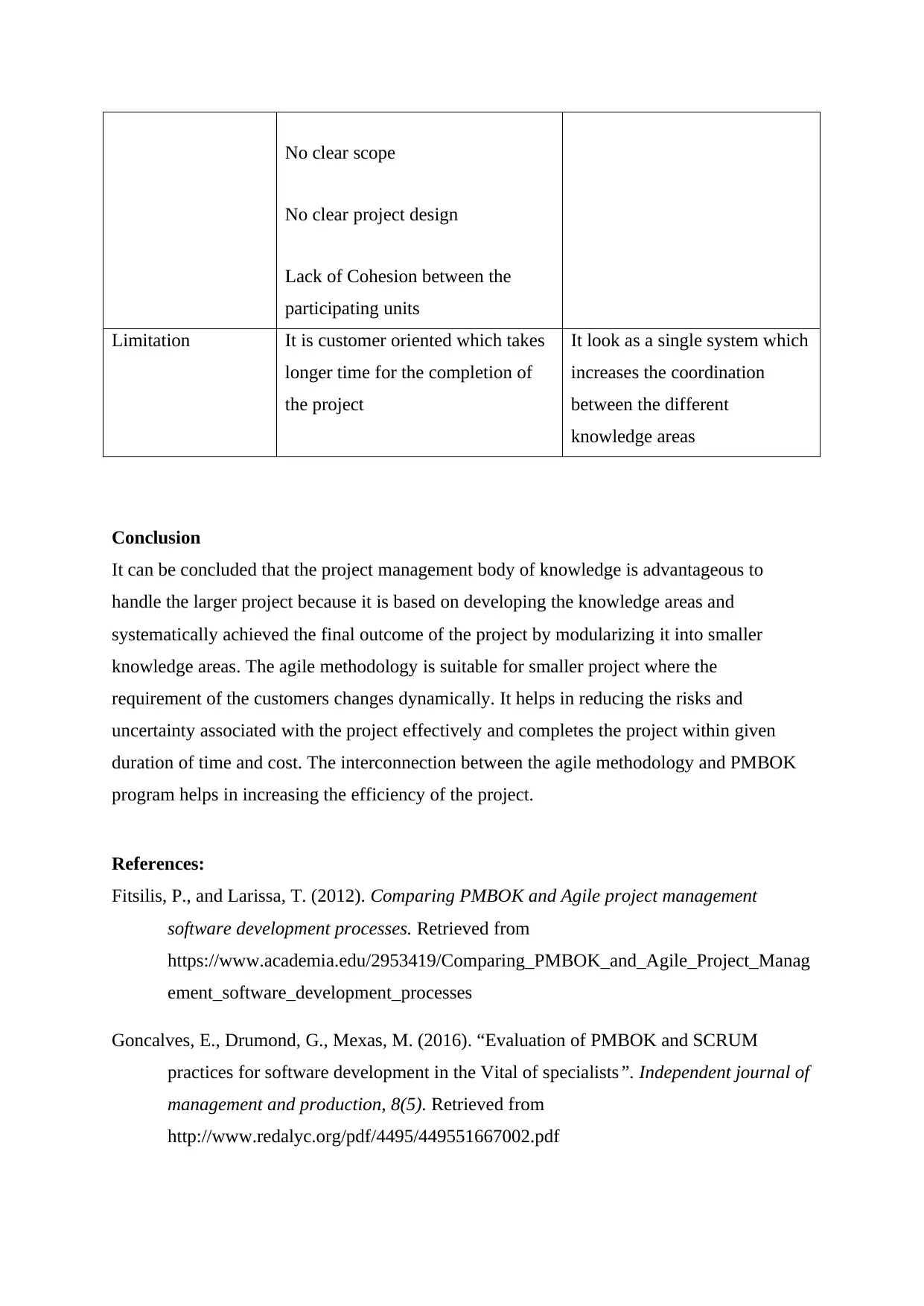
No clear scope
No clear project design
Lack of Cohesion between the
participating units
Limitation It is customer oriented which takes
longer time for the completion of
the project
It look as a single system which
increases the coordination
between the different
knowledge areas
Conclusion
It can be concluded that the project management body of knowledge is advantageous to
handle the larger project because it is based on developing the knowledge areas and
systematically achieved the final outcome of the project by modularizing it into smaller
knowledge areas. The agile methodology is suitable for smaller project where the
requirement of the customers changes dynamically. It helps in reducing the risks and
uncertainty associated with the project effectively and completes the project within given
duration of time and cost. The interconnection between the agile methodology and PMBOK
program helps in increasing the efficiency of the project.
References:
Fitsilis, P., and Larissa, T. (2012). Comparing PMBOK and Agile project management
software development processes. Retrieved from
https://www.academia.edu/2953419/Comparing_PMBOK_and_Agile_Project_Manag
ement_software_development_processes
Goncalves, E., Drumond, G., Mexas, M. (2016). “Evaluation of PMBOK and SCRUM
practices for software development in the Vital of specialists”. Independent journal of
management and production, 8(5). Retrieved from
http://www.redalyc.org/pdf/4495/449551667002.pdf
No clear project design
Lack of Cohesion between the
participating units
Limitation It is customer oriented which takes
longer time for the completion of
the project
It look as a single system which
increases the coordination
between the different
knowledge areas
Conclusion
It can be concluded that the project management body of knowledge is advantageous to
handle the larger project because it is based on developing the knowledge areas and
systematically achieved the final outcome of the project by modularizing it into smaller
knowledge areas. The agile methodology is suitable for smaller project where the
requirement of the customers changes dynamically. It helps in reducing the risks and
uncertainty associated with the project effectively and completes the project within given
duration of time and cost. The interconnection between the agile methodology and PMBOK
program helps in increasing the efficiency of the project.
References:
Fitsilis, P., and Larissa, T. (2012). Comparing PMBOK and Agile project management
software development processes. Retrieved from
https://www.academia.edu/2953419/Comparing_PMBOK_and_Agile_Project_Manag
ement_software_development_processes
Goncalves, E., Drumond, G., Mexas, M. (2016). “Evaluation of PMBOK and SCRUM
practices for software development in the Vital of specialists”. Independent journal of
management and production, 8(5). Retrieved from
http://www.redalyc.org/pdf/4495/449551667002.pdf
⊘ This is a preview!⊘
Do you want full access?
Subscribe today to unlock all pages.

Trusted by 1+ million students worldwide
1 out of 14
Related Documents
Your All-in-One AI-Powered Toolkit for Academic Success.
+13062052269
info@desklib.com
Available 24*7 on WhatsApp / Email
![[object Object]](/_next/static/media/star-bottom.7253800d.svg)
Unlock your academic potential
Copyright © 2020–2025 A2Z Services. All Rights Reserved. Developed and managed by ZUCOL.





